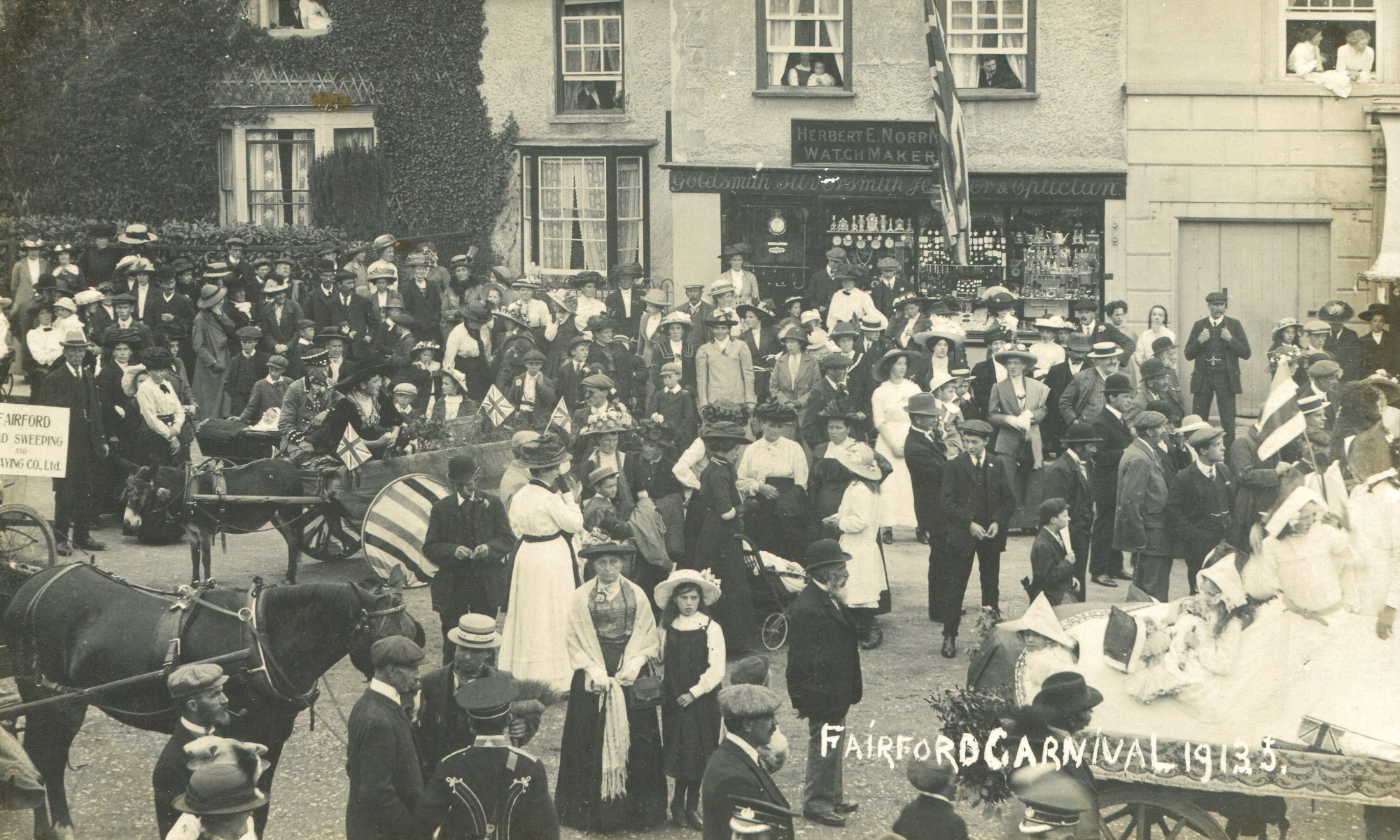Monuments of St Mary’s Church
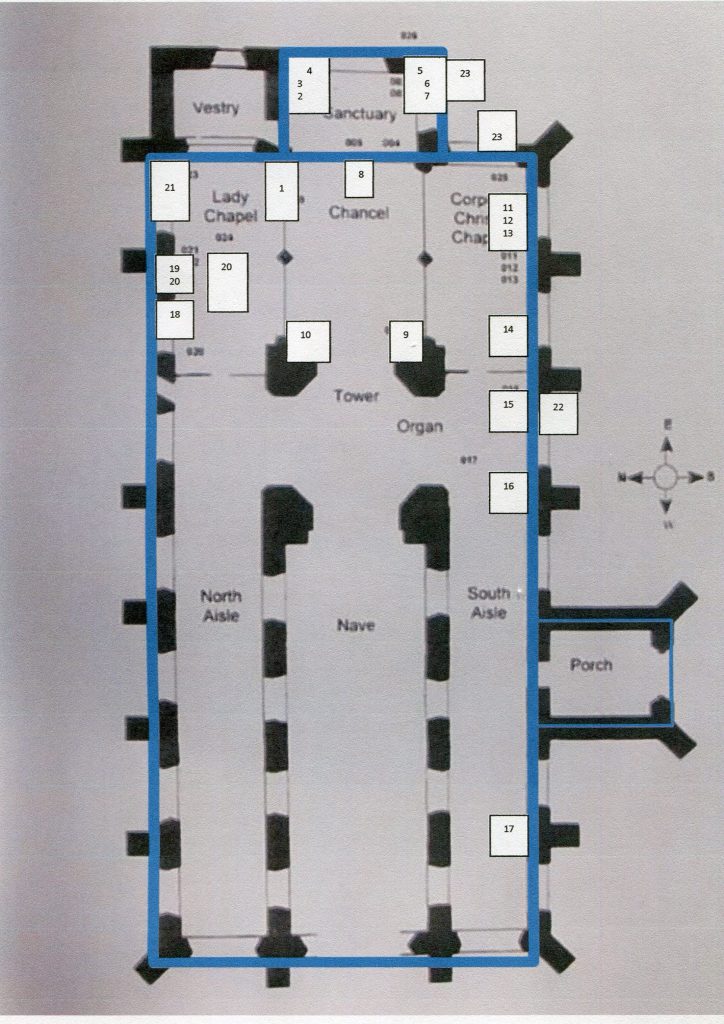
1.John (d.1500) and Alice Tame (d. 1471) Click on this link 1_JOHN TAME 1500
2. Muriel Loggan 1754 – Click on this link- 2_MURIEL LOGGAN 1754
3. William Oldisworth 1680 – Click on this link 3_WILLIAM OLDISWORTH 1680
4.James Oldosworth 1722 – Click on this link 4_JAMES OLDISWORTH 1722
5. Bridget Tracy 1632 – Click on this link 5_BRIDGET TRACY 1632
6. William Oldisworth 1714 – Click on this link 6_WILLIAM OLDISWORTH 1714
7. Keble Family – Click on this link 7_KEBLE FAMILY
8. William Butcher 1715 – Click on this link 8_WILLIAM BUTCHER 1715
9. John Keble 1866 – Click on this link 9_JOHN KEBLE 1866
10. Countess of Rothes 1956 – Click on this link 10_ROTHES 1956
11. Frampton Huntington 1738 – Click on this link 11_FRAMPTON HUNTINGTON 1738
12. Sarah Ready 1731 – Click on this link12_SARAH READY 1731
13. Frederick Wade 1917 – Click on this link13_FREDERICK WADE 1917
14. Henry Jenner 1775 – Click on this link 14_HENRY JENNER 1775
15. John Humphreys 1893 – Click on this link 15_JOHN HUMPHREYS 1803
16. Alexander Colston 1775 – Click on this link 16_ALEXANDER COLSTON 1775
17. George Robbins 1791 – Click on this link 17_GEORGE ROBBINS 1791
18. Albert Palmer 1940 – Click on this link 18_ALBERT PALMER 1940
19. Edmund Tame 1534 – Click on this link 19_EDMUND TAME 1534
20. Raymond Barker 1888 – Click on this link 20_RAYMOND_BARKER 1888
21. Lygons 1584 – Click on this link 21_LYGONS 1584
22.Bettertons 1781 – Click on this link 22_BETTERTONS 1781
23. Morgans 1772 – Click on this link 23_MORGANS 1772
24. Other Monuments: Mary Ann Hitchman, Arthur Smart Loxley, Richard John Bailey, Dorothy Winifred Anne Dowglass, Denys Hodson, Peter and Rosemary Yells, Walter and Gladys Jones – Click on this link – 24_Other Monuments
What lies beneath
During the replacement of the nave floor in St Mary’s during 2009 the workmen discovered several fragments of stone that carried parts of an inscription. The fragments were found beneath the existing surface and had been used as part of the foundations for the floor. Four of the pieces (the largest measuring about 14 inches (35 cm) by 7 inches (18 cm) and about one and a half inches (4 cm) thick were cleaned up to clearly reveal several words and two dates. The surface of the stone had been finished to a very smooth surface with fine lettering but the reverse side was very rough and uneven indicating that it had probably been a grave slab rather than a vertical freestanding headstone. A study of Bigland’s ‘Account of the Parish of Fairford’ of 1791 which lists all the major tombs in the church and the churchyard visible at that date solved the riddle.
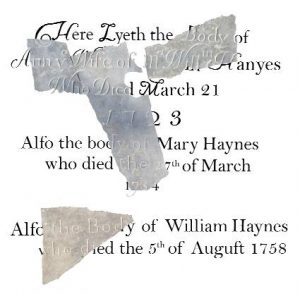 The surviving lettering matched perfectly the inscription on the grave of William and Ann Haynes and their daughter Mary who died in 1758, 1723 and 1754 respectively. Bigland records this as “On a flat stone in the South Aisle” of the church. It would appear that the Haynes stone was removed and broken up to be used as rubble during the reflooring of the church, possibly in 1854 when the church seating was replaced. Unfortunately this is by no means an isolated example of the length to which the Victorians would go to ‘beautify’ our churches. William Haynes had been a churchwarden for many years but even this didn’t stop his memorial being smashed up after less than 100 years.
The surviving lettering matched perfectly the inscription on the grave of William and Ann Haynes and their daughter Mary who died in 1758, 1723 and 1754 respectively. Bigland records this as “On a flat stone in the South Aisle” of the church. It would appear that the Haynes stone was removed and broken up to be used as rubble during the reflooring of the church, possibly in 1854 when the church seating was replaced. Unfortunately this is by no means an isolated example of the length to which the Victorians would go to ‘beautify’ our churches. William Haynes had been a churchwarden for many years but even this didn’t stop his memorial being smashed up after less than 100 years.
The surviving pieces of the Haynes family gravestone can now be seen in the Archive Room in the Community Centre.
One wonders what else lies beneath the pavement in St Mary’s!
St Mary’s Church, Fairford
Although there has been a church at Fairford since at least 1125, only fragments of an early building now remain, having been incorporated into the magnificent Late Perpendicular church of St Mary the Virgin that we see today. The rebuilding of the church was started by John Tame in the early 1490s after been given permission by the Bishop of Worcester to dismantle the existing church. As Tame’s fortune was acquired through the wool and cloth industry, St Mary’s can be counted as among a number of so-called ‘wool’ churches built in the Cotswolds in the medieval period. The new church at Fairford was consecrated in a ceremony presided over by the Bishop on 20 June 1497, an event marked by a painted Consecration Cross on the wall of the chancel near the vestry door. Although structurally complete, the church was still far from finished at this point and at the death of John Tame in 1500 his son Edmund Tame undertook to complete the work. At about this time work commenced on the production of 28 painted glass windows that would make up a stunning visual account of the Bible story from Adam and Eve through to the Last Judgement and would provide instruction as well as illumination, in both senses of the word. The story that these windows tell also reveals the central role of the Virgin Mary to pre-Reformation English liturgy. Fairford’s windows remain the most complete set of medieval church windows in the country and are therefore of national importance.
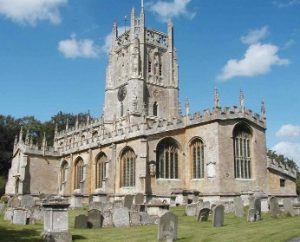
St Mary’s church, as rebuilt by the Tames, consists of a central nave flanked by two aisles that each originally terminated in a side chapel. On the north side the Lady Chapel contains the tomb of John Tame and his wife Alice. A monumental brass depicts the pair and the tomb is now surmounted by a beautifully carved wooden screen added in about 1520 and which serves to separate the chapel from the chancel.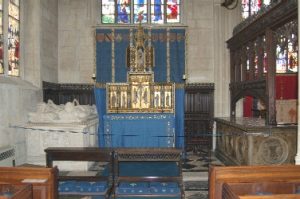 Also in the Lady Chapel is a chest tomb tomb with life-size stone effigies of Roger Lygon and his wife Katherine, widow of the grandson of John Tame. Beneath the floor of the chapel is a vault containing the remains of Sir Edmund Tame and his wives, Agnes and Elizabeth, all commemorated by a brass on the chapel’s north wall.
Also in the Lady Chapel is a chest tomb tomb with life-size stone effigies of Roger Lygon and his wife Katherine, widow of the grandson of John Tame. Beneath the floor of the chapel is a vault containing the remains of Sir Edmund Tame and his wives, Agnes and Elizabeth, all commemorated by a brass on the chapel’s north wall.
The Corpus Christi Chapel on the south side of the church is of less interest but it does have a fine marble monument to Sarah Ready who died in 1731. The almost complete set of wooden screens in the choir is particularly fine and date from around 1520. The wooden stalls are thought to date from around 1300 and may possibly have come from Cirencester Abbey following its dismantling during the Dissolution of the Monasteries in about 1540. The choir also contains a set of 14 misericord seats that incorporate carvings showing various forms of sin or strife, obviously done with a moral intent. The almost perfect symmetry of the Church building plan was spoiled at a later date by the addition of a sacristy or vestry beyond the Lady Chapel, however this does little to mar the visual effect of what is one of the most beautiful churches in the Cotswolds.
Now situated in the middle of Tame’s rebuilt church, the lower portion of the tower is the oldest part of the building. The later work to increase the height of the tower is apparent from the exterior where a change in the stonework and shape of the corner buttresses indicate the newer building. On the interior columns that form the base of the tower can still be seen traces of late medieval wall paintings including several figures (one of which may be St Christopher) and simple patterns. The roof of the church is supported by a total of 69 stone angels that adorn the corbels of the wooden roof beams. There are a number of wall-mounted monuments to past Fairford citizens including three to the Oldisworth family.
The exterior of the building contains a wealth of decoration and sculpture of great interest. Some of the decoration reflects the patronage of Fairford’s church and includes the gryphon and bear and ragged staff of the Earl of Warwick, an early lord of the manor. The coat of arms of John Tame, consisting of a Wyvern and a lion, can be seen above the door into the church from the porch. A series of curious figures adorn the stringcourse below the embattled parapet that runs all around the outside of the church. 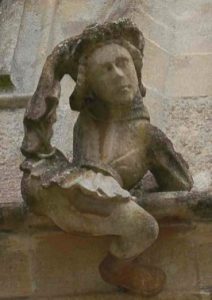 These sculptures include a dragon, a lion, a dog, a sheep and, most charming of all, a boy in the act of climbing down from the parapet (right). In addition to these sculptures are figures of a more serious nature including the Christ of Pity at the west end of the church and four fierce guardians standing sentry at the four corners of the tower.
These sculptures include a dragon, a lion, a dog, a sheep and, most charming of all, a boy in the act of climbing down from the parapet (right). In addition to these sculptures are figures of a more serious nature including the Christ of Pity at the west end of the church and four fierce guardians standing sentry at the four corners of the tower.
The graveyard of St Mary’s contains some fine examples of Cotswold tombs including several that have Listed Building status as being of historical and architectural importance. There are several examples of large chest tombs, some of them surmounted by semi-circular spiralled slabs once thought to represent bales of wool. One of the earliest monuments in the graveyard is that of Valentine Strong who died in 1662 and was a well-known Cotswold stonemason and architect who built Fairford Park and Lower Slaughter Manor among other buildings. There is also a fine set of three listed tombs of the Morgan family situated outside the end of the Corpus Christi Chapel. 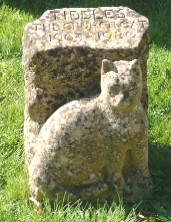 Among the grand and ancient tombs in the churchyard is a delightful stone sculpture of ‘Tiddles’, a much-loved Church cat who ‘guarded’ the church and its precincts from 1963 to 1980.
Among the grand and ancient tombs in the churchyard is a delightful stone sculpture of ‘Tiddles’, a much-loved Church cat who ‘guarded’ the church and its precincts from 1963 to 1980.
Chris Hobson
Further reading:
The Great Storm of 1703 https://www.fairfordhistory.org.uk/the-great-storm-1703/
The buildings of England. Gloucestershire 1: The Cotswolds by David Verey and Alan Brooks. London: Yale University Press, 2002
Fairford Church and its stained glass windows by Oscar G Farmer. Various editions, 1928-1968
The medieval stained glass of Fairford parish church by Sarah Brown and Lindsay MacDonald. Revised pbk edition. Stroud: Sutton Publishing, 2007
The Great Storm, 1703
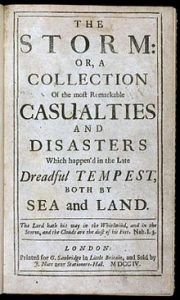 The Great Storm of 26 November 1703 was one of the most powerful and destructive storms in recorded English history. The storm came in from the Atlantic and cut a swathe of destruction across southern and central England and out into the North Sea. In London about 2,000 chimney stacks were blown down and at least 1,500 men were lost at sea as many ships, including the Royal Navy’s entire Channel Squadron, were sunk. One warship was blown from Harwich all the way to Gothenburg in Sweden before it was able to sail back to England. There was extensive flooding in the West Country where hundreds of people and thousands of livestock were drowned in the Somerset Levels. Other instances of destruction include about 400 windmills which were destroyed, about 4,000 oak trees in the New Forest blown down, and the collapse of the first Eddystone Lighthouse.
The Great Storm of 26 November 1703 was one of the most powerful and destructive storms in recorded English history. The storm came in from the Atlantic and cut a swathe of destruction across southern and central England and out into the North Sea. In London about 2,000 chimney stacks were blown down and at least 1,500 men were lost at sea as many ships, including the Royal Navy’s entire Channel Squadron, were sunk. One warship was blown from Harwich all the way to Gothenburg in Sweden before it was able to sail back to England. There was extensive flooding in the West Country where hundreds of people and thousands of livestock were drowned in the Somerset Levels. Other instances of destruction include about 400 windmills which were destroyed, about 4,000 oak trees in the New Forest blown down, and the collapse of the first Eddystone Lighthouse.
Amongst the list of damage done by the storm can be added Fairford’s church and its nationally-important windows. Soon after the storm the author Daniel Defoe (who would later write the novel Robinson Crusoe) asked for first-hand accounts of the effects of the storm with the aim of writing a detailed account of the disaster which was published in 1704. One of the many people who responded to Defoe’s request was the Reverend Edward Shipman, the vicar of Fairford from 1686 to 1711. His letter to Defoe was reprinted in Gloucestershire Notes and Queries:
“Honoured Sir, In obedience to your request I have here sent you a particular account of the damages sustained in our parish by the late violent storm; and because that of our church is the most material which I have to impart to you, I shall therefore begin with it. It is the fineness of our church which magnifies our present loss, for in the whole it is a large and noble structure, composed within and without of ashler curiously wrought, and consisting of a stately roof in the middle, and two isles running a considerable length from one end of it to the other, makes a very beautiful figure. It is also adorned with 28 admired and celebrated windows, which, ‘for the variety and fineness of the painted glass that was in them, do justly attract the eyes of all curious travellers to inspect and behold them; nor is it more famous for its glass, than newly renowned for the beauty of its seats and paving, both being chiefly the noble gift of that pious and worthy gentleman Andrew Barker, Esq.,the late deceased lord of the manor. So that all things considered, it does equal, at least, if not exceed, any parochial church in England. Now that part of it which most of all felt the fury of the winds, was, a large middle west window, in dimension about 15 foot wide, and 25 foot high, it represents the general judgment, and is so fine a piece of art, that £1500 has formerly been bidden for it, a price, though very tempting, yet were the parishioners so just and honest to refuse it. The upper part of this window, just above the place where our Saviour’s picture is drawn sitting on a rainbow, and the earth his footstool, is entirely ruined, and both sides are so shattered and torn, especially the left, that upon a general computation, a fourth part at least is blown down and destroyed. The like fate has another west window on the left side of the former, in dimension about 10 foot broad, and 15 foot high, sustained ; the upper half of which is totally broke, excepting one stone munnel. Now if these were but ordinary glass, we might quickly compute what our repairs would cost, but we the more lament our misfortune herein, because the paint of these two as of all the other windows in our church, is stained through the body of the glass; so that if that be true which is generally said, that this art is lost, then have we an irretrievable loss. There are other damages about our church, which, though not so great as the former, do yet as much testify how strong and boisterous the winds were, for they unbedded 3 sheets of lead upon the uppermost roof, and rolled them up like so much paper. Over the church porch, a large pinnacle and two battlements were blown down upon the leads of it, but resting there, and their fall being short, these will be repaired with little cost.
This is all I have to say concerning our church : our houses come next to be considered, and here I may tell you, that (thanks be to God) the effects of the storm were not so great as they have been in many other places ; several chimnies, and tiles, and slates, were thrown down, but nobody killed or wounded. Some of the poor, because their houses were thatched, were the greatest sufferers; but to be particular herein, would be very frivolous, as well as vexatious. One instance of note ought not to be omitted; on Saturday, the 26th, being the day after the storm, about 2 o’clock in the afternoon, without any previous warning, a sudden flash of lightning, with a short, but violent clap of thunder, immediately following it like the discharge of ordnance, fell upon a new and strong built house in the middle of our town, and at the same time disjointed two chimnies, melted some of the lead of an upper window, and struck the mistress of the house into a swoon, but this, as appeared afterwards, proved the effect more of fear, than of any real considerable hurt to be found about her. I have nothing more to add, unless it be the fall of several trees and ricks of hay amongst us, but these being so common everywhere, and not very many in number here, I shall conclude this tedious scribble, and subscribe myself,
Sir, your most obedient and humble servant,
EDW. SHIPTON, Vicar. [This should be Shipman]
Fairford, Gloucester, Jan., 1704.
The damage to Fairford’s west windows was repaired but some of the glass panels were destroyed and some were put back in the wrong position. It was not until the windows were renovated in the early years of the 20th century that these mistakes were corrected. It was not just Fairford’s church that was damaged, Wells Cathedral also lost part of its great west window and the Bishop of Bath and Wells and his wife died when the chimney stack of the Bishop’s Palace collapsed into their bedroom.
Despite the grievous damage to the church and some of Fairford’s housing at least the storm did not result in any deaths in the town. In all it has been estimated that about 8,000 people died as a result of the Great Storm of 1703 making it the most destructive storm in British history.
This event is also recorded in the book ‘The Greatest Storm: Britain’s Night of Destrution, November 1703 by Martin Brayne, 2003’
Celebration of the completion of the restoration of St Mary’s Church windows June 11-14 2010
As part of the weekend of celebrations FHS mounted ‘A history of the Church’ exhibition which took place in the Heritage Room of the Community Centre. This recorded the historical timeline of the Church plus and other information and artifacts from the FHS Archive. Edwin Cuss supplied pictures of the 28 medieval glass windows in black and white taken by Henry Taunt in the late Nineteenth/early Twentieth century plus Church events that had taken place through out the years. See the Church Website.
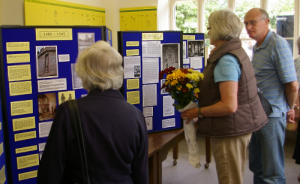 A very interesting item was the ‘Fairford Booke’ lent by Gloucestershire Archives with permission of the Fairford Church Lands Charity.The book consists of copies of 17th Century legal documents relating to Fairford land transactions including church and charity lands (enfeoffments).The earliest document is dated 1601 and the book contains many references to Fairford people from 400 years ago including the Barkers, the Oldisworths, the Bettertons, and the Gearings. Several pieces of land are mentioned including Beane Lands and Swann Fields in Fairford and Butler’s Court in Lechlade.
A very interesting item was the ‘Fairford Booke’ lent by Gloucestershire Archives with permission of the Fairford Church Lands Charity.The book consists of copies of 17th Century legal documents relating to Fairford land transactions including church and charity lands (enfeoffments).The earliest document is dated 1601 and the book contains many references to Fairford people from 400 years ago including the Barkers, the Oldisworths, the Bettertons, and the Gearings. Several pieces of land are mentioned including Beane Lands and Swann Fields in Fairford and Butler’s Court in Lechlade.
Also on display were pictures of former vicars, one of whom, the Rev Loxley was portrayed in a particularly languid pose and many of the visitors thought that the present vicar ought to be similarly photograp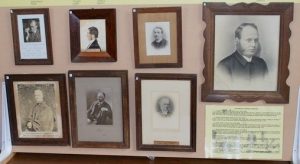 hed!
hed!
